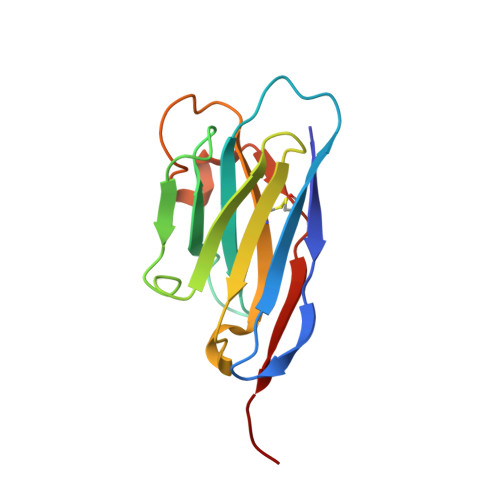An ER-directed gelsolin nanobody targets the first step in amyloid formation in a gelsolin amyloidosis mouse model.
Van Overbeke, W., Wongsantichon, J., Everaert, I., Verhelle, A., Zwaenepoel, O., Loonchanta, A., Burtnick, L.D., De Ganck, A., Hochepied, T., Haigh, J., Cuvelier, C., Derave, W., Robinson, R.C., Gettemans, J.(2015) Hum Mol Genet 24: 2492-2507
- PubMed: 25601851
- DOI: https://doi.org/10.1093/hmg/ddv010
- Primary Citation of Related Structures:
4S10, 4S11 - PubMed Abstract:
Hereditary gelsolin amyloidosis is an autosomal dominantly inherited amyloid disorder. A point mutation in the GSN gene (G654A being the most common one) results in disturbed calcium binding by the second gelsolin domain (G2). As a result, the folding of G2 is hampered, rendering the mutant plasma gelsolin susceptible to a proteolytic cascade. Consecutive cleavage by furin and MT1-MMP-like proteases generates 8 and 5 kDa amyloidogenic peptides that cause neurological, ophthalmological and dermatological findings. To this day, no specific treatment is available to counter the pathogenesis. Using GSN nanobody 11 as a molecular chaperone, we aimed to protect mutant plasma gelsolin from furin proteolysis in the trans-Golgi network. We report a transgenic, GSN nanobody 11 secreting mouse that was used for crossbreeding with gelsolin amyloidosis mice. Insertion of the therapeutic nanobody gene into the gelsolin amyloidosis mouse genome resulted in improved muscle contractility. X-ray crystal structure determination of the gelsolin G2:Nb11 complex revealed that Nb11 does not directly block the furin cleavage site. We conclude that nanobodies can be used to shield substrates from aberrant proteolysis and this approach might establish a novel therapeutic strategy in amyloid diseases.
Organizational Affiliation:
Department of Biochemistry, Faculty of Medicine and Health Sciences.














